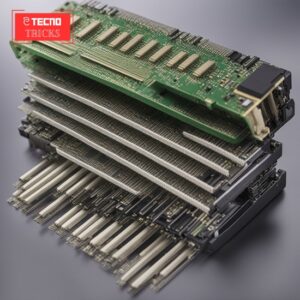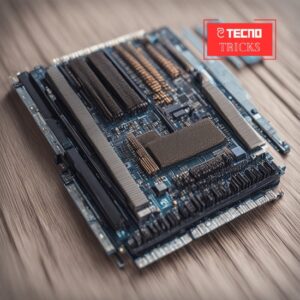Introduction:
You might think that how to check ram type in windows 11 is a daunting task, reserved only for tech wizards or computer experts. However, I’m here to tell you that it’s easier than you think! Understanding your RAM type can significantly improve your system’s performance, making tasks smoother and faster. In this guide, I’ll walk you through the process step-by-step, debunking any myths along the way.
How To Check Ram Type In Windows 11 Matters:
Your computer’s RAM, or Random Access Memory, is like its short-term memory. It’s where your operating system and applications store data temporarily while they’re in use. Knowing your RAM type is crucial because different types of RAM have varying speeds and capabilities. Using the wrong type of RAM or mixing incompatible types can lead to performance issues and system instability. By identifying your RAM type, you can ensure optimal performance and compatibility with your hardware and software.
Step-by-Step Guide How To Check Ram Type In Windows 11:
Open System Information:
The first step is to access the System Information tool in Windows 11. You can do this by pressing the Windows key + R to open the Run dialog, typing “msinfo32”, and hitting Enter.
Navigate to Components:
Once the System Information window opens, navigate to the “Components” section in the left-hand sidebar and click on “Memory”.
Find RAM Type:
In the right-hand pane, you’ll see various details about your computer’s memory. Look for the “Type” field under “Memory Device” to find out the type of RAM installed on your system.
Note Down the Information:
Take note of the RAM type listed. It could be DDR3, DDR4, or another type depending on your system configuration.
Close System Information:
Once you’ve gathered the necessary information, you can close the System Information tool.
Use Command Prompt (Optional):
Alternatively, you can also use the Command Prompt to check your RAM type. Simply open Command Prompt and type “wmic memorychip get memorytype” followed by Enter.
Interpret the Results:
The Command Prompt will display the memory type of your RAM modules. Compare this information with what you found in the System Information tool to verify accuracy.
By following these steps, you can easily check your RAM type in Windows 11 and ensure that your system is running at its best.
Using Built-in Tools How To Check Ram Type In Windows 11:
Contrary to popular belief, you don’t need to rely on third-party software or advanced technical knowledge to check your RAM type in Windows 11. Microsoft has provided built-in tools that make the process simple and straightforward. In this section, we’ll explore these tools and how you can leverage them to identify your RAM type with ease.
Task Manager:
One of the quickest ways to check your RAM type in Windows 11 is through the Task Manager. Simply right-click on the taskbar and select “Task Manager” from the menu. Once Task Manager is open, navigate to the “Performance” tab. Here, you’ll see a breakdown of your system’s performance metrics, including memory usage. Click on “Memory” to view more detailed information, such as your installed RAM type.
System Information Tool:
As mentioned earlier, the System Information tool in Windows 11 provides comprehensive information about your computer’s hardware and software configuration. To access this tool, press the Windows key + R to open the Run dialog, type “msinfo32”, and hit Enter. In the System Information window, navigate to the “Components” section and click on “Memory” to view details about your RAM, including the type.
Control Panel:
Another method for checking your RAM type in Windows 11 is through the Control Panel. Open the Control Panel by searching for it in the Start menu or pressing the Windows key + X and selecting “Control Panel” from the menu. In the Control Panel, navigate to “System and Security” > “System” > “View amount of RAM and processor speed”. Here, you’ll find information about your installed RAM, including the type.
Windows PowerShell:
For those comfortable with using command-line interfaces, Windows PowerShell provides an alternative method for checking RAM type. Open PowerShell by searching for it in the Start menu or pressing the Windows key + X and selecting “Windows PowerShell” from the menu. Once PowerShell is open, type the command “Get-WmiObject Win32_PhysicalMemory | Select-Object Manufacturer, Speed, MemoryType” (without quotes) and hit Enter. This command will display detailed information about your RAM, including the type.
Interpreting the Results:
Regardless of which method you use to check your RAM type in Windows 11, it’s essential to understand the information presented. Look for the “Type” or “MemoryType” field, which will indicate the type of RAM installed on your system, such as DDR3 or DDR4. This information is valuable for troubleshooting compatibility issues and ensuring optimal system performance.
By utilizing these built-in tools in Windows 11, you can easily check your RAM type without the need for additional software or technical expertise. Stay tuned for the next sections, where we’ll explore alternative methods for identifying RAM type and troubleshooting common issues.
Pros and Cons:
Each method for checking RAM type in Windows 11 boasts its own set of advantages and limitations. The Task Manager provides a quick and intuitive interface, ideal for users seeking immediate insights. The System Information tool offers comprehensive details, catering to users with a penchant for thorough analysis. The Control Panel provides a familiar environment, ensuring accessibility for users of all proficiency levels. Windows PowerShell offers unparalleled flexibility and customization options, but may intimidate novice users with its command-line interface.
Final Verdict:
In conclusion, Windows 11 offers a diverse array of built-in tools for checking RAM type, catering to users of all proficiency levels. Whether you prefer the simplicity of Task Manager, the thoroughness of System Information, the familiarity of the Control Panel, or the flexibility of PowerShell, Windows 11 ensures accessibility and convenience. By leveraging these tools, users can gain invaluable insights into their system’s hardware configuration, empowering them to optimize performance and compatibility.
Frequently Asked Questions (FAQs):
Q: Can I check my RAM type in Windows 11 without any additional software? A: Absolutely! Windows 11 comes with built-in tools like Task Manager, System Information, Control Panel, and PowerShell that allow you to check your RAM type without the need for extra software.
Q: Is it difficult to check my RAM type using these built-in tools? A: Not at all! The process is straightforward and user-friendly, with step-by-step instructions provided in our guide. Whether you’re a beginner or an experienced user, you’ll find these tools easy to navigate.
Q: What if I’m not familiar with command-line interfaces like PowerShell? A: No worries! While PowerShell offers advanced functionality, it’s not the only option for checking RAM type. You can use simpler tools like Task Manager or System Information if you’re more comfortable with graphical interfaces.
Q: Why is it important to know my RAM type in Windows 11? A: Understanding your RAM type is crucial for optimizing system performance and ensuring compatibility with hardware and software. Different RAM types have varying speeds and capabilities, so knowing which type you have can help you make informed decisions when upgrading or troubleshooting your system.
Q: Can I use these methods to check RAM type on any Windows 11 PC? A: Yes, the built-in tools we’ve mentioned are available on all Windows 11 PCs, so you can use them to check your RAM type regardless of your device’s manufacturer or specifications.
Q: Will checking my RAM type affect my computer’s performance? A: Not at all! Checking your RAM type is a non-invasive process that simply involves gathering information about your hardware configuration. It won’t have any impact on your computer’s performance.
Q: Can I use these tools to check other hardware components besides RAM? A: Yes, the built-in tools in Windows 11 provide information about various hardware components, including CPU, storage, and more. You can use them to gather details about your entire system configuration.
Q: What if I encounter any difficulties while using these tools? A: If you run into any issues or have trouble navigating the built-in tools, don’t hesitate to reach out for assistance. There are plenty of online resources and communities where you can find help and support from experienced users.







